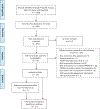A Systematic Review of Patient-Reported Outcome Measures Assessing Body Image Disturbance in Patients with Head and Neck Cancer
- PMID: 30744514
- PMCID: PMC6546516
- DOI: 10.1177/0194599819829018
A Systematic Review of Patient-Reported Outcome Measures Assessing Body Image Disturbance in Patients with Head and Neck Cancer
Abstract
Objective: To synthesize published literature describing the severity of body image disturbance (BID) in patients with head and neck cancer (HNC) over time, its psychosocial and functional associations, and treatment strategies as assessed by patient-reported outcome measures (PROMs).
Data source: PubMed/MEDLINE, Scopus, PsycINFO, Web of Science, and Google Scholar.
Review methods: A systematic review of the English-language literature was performed to identify studies of BID in patients with HNC using psychometrically validated PROMs to assess (1) severity of BID over time, (2) psychosocial and functional associations, and (3) management strategies.
Results: A total of 17 studies met inclusion criteria. BID was assessed via 10 different PROMs, none of which were HNC-specific measures of BID. Two of 2 longitudinal studies (100%) reported that BID improved from pretreatment to posttreatment, and 2 of 3 longitudinal studies (67%) showed that the severity of BID decreased over time as survivors got further out from treatment. Seven of 17 studies (41%) described negative functional and psychosocial associations with BID, although study methodology limited conclusions about cause and effect. None of the studies assessing interventions to manage BID (0/2, 0%) demonstrated an improvement in BID relative to control.
Conclusion: BID in patients with HNC has negative functional and psychosocial associations and lacks evidence-based treatment. Research is limited by the lack of an HNC-specific BID PROM. Further research should address knowledge gaps related to the lack of an HNC-specific BID PROM, longitudinal course of BID in patients with HNC, confusion with regards to risk factors and outcomes, and lack of prevention and treatment strategies.
Keywords: body image disturbance; head and neck cancer; patient reported outcome measures; systematic review.
Conflict of interest statement
Disclosures
Figures
Similar articles
-
Validation of a Novel, Multidomain Head and Neck Cancer Appearance- and Function-Distress Patient-Reported Outcome Measure.Otolaryngol Head Neck Surg. 2020 Nov;163(5):979-985. doi: 10.1177/0194599820927364. Epub 2020 Jun 2. Otolaryngol Head Neck Surg. 2020. PMID: 32482151
-
Factors Associated With Risk of Body Image-Related Distress in Patients With Head and Neck Cancer.JAMA Otolaryngol Head Neck Surg. 2021 Dec 1;147(12):1019-1026. doi: 10.1001/jamaoto.2021.1378. JAMA Otolaryngol Head Neck Surg. 2021. PMID: 34236423 Free PMC article.
-
Protocol for a multisite, parallel-group, randomized clinical trial comparing a brief tele-cognitive behavioral therapy intervention (BRIGHT) with attention control for the reduction of body image-related distress among head and neck cancer survivors.Contemp Clin Trials. 2025 Jun;153:107888. doi: 10.1016/j.cct.2025.107888. Epub 2025 Mar 24. Contemp Clin Trials. 2025. PMID: 40139457
-
A systematic review of body image measures for people diagnosed with head and neck cancer (HNC).Support Care Cancer. 2019 Oct;27(10):3657-3666. doi: 10.1007/s00520-019-04919-6. Epub 2019 Jun 15. Support Care Cancer. 2019. PMID: 31203508
-
Nutrition impact symptoms and associated outcomes in post-chemoradiotherapy head and neck cancer survivors: a systematic review.J Cancer Surviv. 2018 Aug;12(4):479-494. doi: 10.1007/s11764-018-0687-7. Epub 2018 Mar 20. J Cancer Surviv. 2018. PMID: 29556926
Cited by
-
Proposal of Dental Hygiene Diagnosis for Cancer Patients Based on Dental Hygiene Process of Care in Acute Care Hospitals: A Narrative Review.Healthcare (Basel). 2020 Jul 18;8(3):217. doi: 10.3390/healthcare8030217. Healthcare (Basel). 2020. PMID: 32708439 Free PMC article. Review.
-
Body Image Concerns in Patients With Head and Neck Cancer: A Longitudinal Study.Front Psychol. 2022 Mar 24;13:816587. doi: 10.3389/fpsyg.2022.816587. eCollection 2022. Front Psychol. 2022. PMID: 35401366 Free PMC article.
-
Body image concerns in long-term head and neck cancer survivors: prevalence and role of clinical factors and patient-reported late effects.J Cancer Surviv. 2023 Apr;17(2):526-534. doi: 10.1007/s11764-022-01311-y. Epub 2022 Dec 13. J Cancer Surviv. 2023. PMID: 36509859 Free PMC article.
-
Body image and social appearance anxiety in patients with cancer undergoing radiotherapy: Across-sectional study.BMC Psychol. 2024 Jun 24;12(1):363. doi: 10.1186/s40359-024-01856-w. BMC Psychol. 2024. PMID: 38915070 Free PMC article.
-
Trajectories and interactions of body image and subjective well-being in colorectal cancer patients with colostomy: a longitudinal study.Support Care Cancer. 2025 Jul 22;33(8):711. doi: 10.1007/s00520-025-09773-3. Support Care Cancer. 2025. PMID: 40694242
References
-
- Parkin DM, Bray F, Ferlay J, Pisani P. Global cancer statistics, 2002. CA Cancer J Clin. 2005;55:74–108. - PubMed
-
- Jansen F, Snyder CF, Leemans CR, Verdonck—de Leeuw IM. Identifying cutoff scores for the EORTC QLQ-C30 and the head and neck cancer—specific module EORTC QLQ-H&N35 representing unmet supportive care needs in patients with head and neck cancer. Head Neck. 2016;38(suppl 1):E1493–E1500. - PubMed
-
- Murphy BA, Ridner S, Wells N, Dietrich M. Quality of life research in head and neck cancer: a review of the current state of the science. Crit Rev Oncol. 2007;62:251–267. - PubMed
-
- De Boer MF, McCormick LK, Pruyn JF, Ryckman RM, van den Borne BW. Physical and psychosocial correlates of head and neck cancer: a review of the literature. Otolaryngol Head Neck Surg. 1999;120:427–436. - PubMed
Publication types
MeSH terms
Grants and funding
LinkOut - more resources
Full Text Sources
Medical
Miscellaneous


